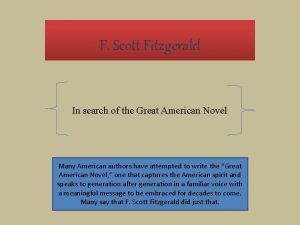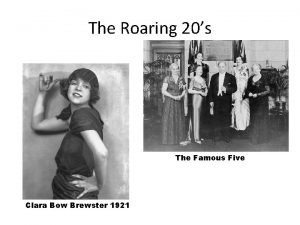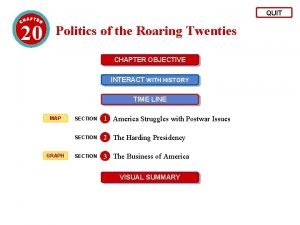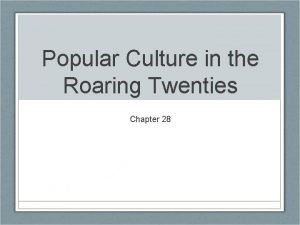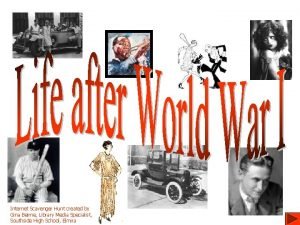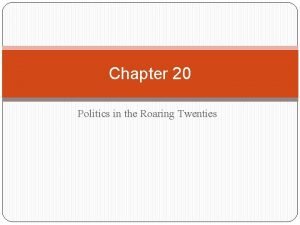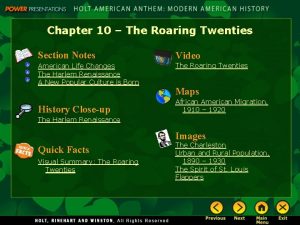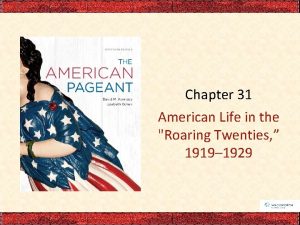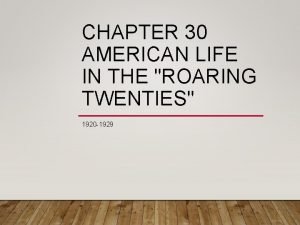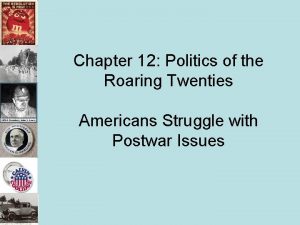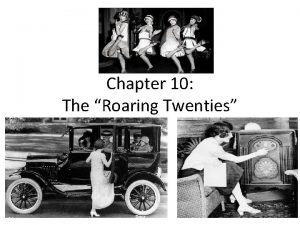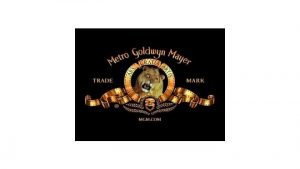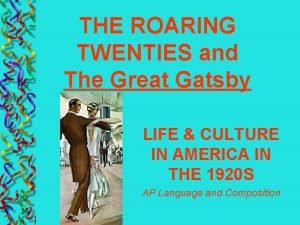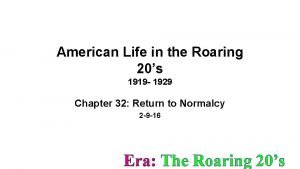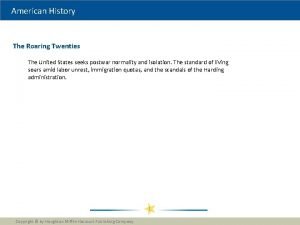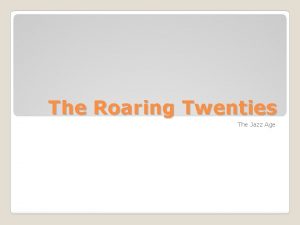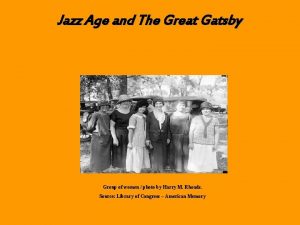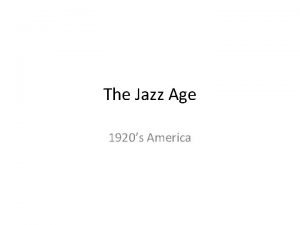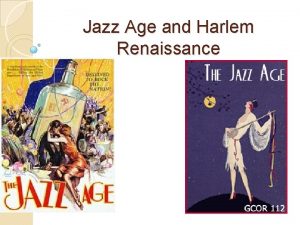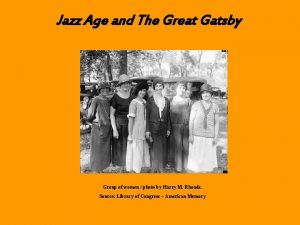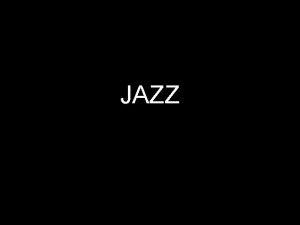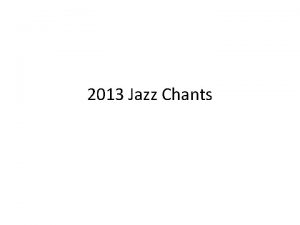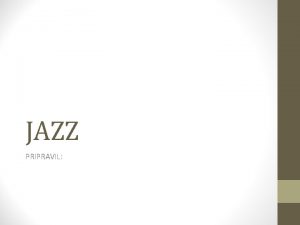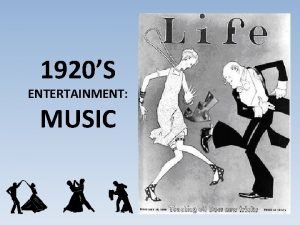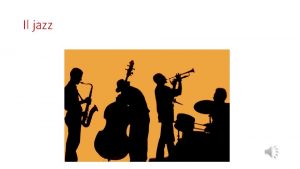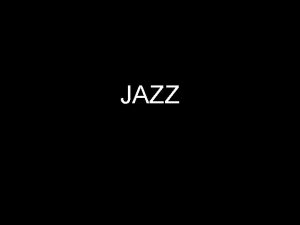The Roaring Twenties The Jazz Age Essential Question
















- Slides: 16

The Roaring Twenties The Jazz Age

�Essential Question: ◦ Was American society in the 1920 s a modern culture with a traditionalist reaction or a traditional society with a modern critique? The Roaring Twenties

Presidents of the 1920 s Warren G. Harding (R) (1921 -1923) Calvin Coolidge (R) (1923 -1929) Herbert Hoover (R) (1929 -1933) Republican presidents during the 1920 s were politically conservative (supportive of big business and generally unsupportive of labor and government regulation of the economy) and isolationist

�Many significant social and technological changes posed challenges to American traditions and facilitated cultural change and modern thought in the 1920 s and 30 s. Unit 7 Understanding

Modernism Traditionalism � Technology/ � Nativism Industrialization � Consumerism � Urbanization � Individualism/Cultural Expression � Jazz Age � Racism � Fundamentalism � Prohibition � Isolationism � Political The Roaring Twenties (1920 -1929) Conservatism

� The horrors of World War I destroyed the belief that Western civilization was actually progressing. � The war’s destruction produced a postwar disillusionment among young intellectuals (who would challenge old values) � Modernist thought began out of the recognition that Western civilization was rapidly changing ◦ New technologies, new modes of transportation and communication, and new scientific discoveries such as quantum physics and relativity theory combined to alter perceptions of reality and generate new forms of artistic expression. �A new “modernist” mood and movement emerged among artists, writers, and intellectuals. � At the same time that the war accelerated the notion of modernism, it also stimulated political and social radicalism. Modernism

�The postwar wave of labor strikes, bombings, the rise in Communist membership and race riots convinced many that America had entered a frightening new era of too much diversity and change (this came to be viewed as radicalism) �Defenders of tradition of the 1920 s fed on a growing tendency to connect American nationalism with nativism and Anglo-Saxon racism. Traditionalism

�In the early 1920 s, over half of the white men and a third of the white women working in manufacturing industries were foreign born, most of them from central or eastern Europe. �Since socialism and anarchism were popular in these regions, many such immigrant workers were deemed “suspicious” in the eyes of old stock American workers Nativism

� During World War I immigration stopped; afterwards immigration increased greatly � Nativists warned that these immigrants would threaten the American way of life � As fears increased, Congress passed the Emergency Immigration Act of 1921, which restricted new arrivals each year to 3 percent of the foreign born of any nationality as shown in the 1910 census. � A new quota law in 1924 reduced the number to 2 percent based on the 1890 census � purpose : to tilt the balance in favor of immigrants from northern and western Europe, who were assigned about 85 percent of the total. Nativism

�Nativist tradition also took on a new form in that of a revised Ku Klux Klan. �The new Klan was devoted to “ 100 percent Americanism” and restricted its membership to native-born white Protestants. �The Klan was determined to protect its vision of American life from not only African-Americans, but also from Roman Catholics, Jews, and immigrants Anglo-Saxon Racism

Nicolo Sacco and Bartolomeo Vanzetti “A good shoemaker and a poor fish peddler”

◦ A year after their arrest—the jury deliberated for 5 hours before convicting both men of robbery and murder ◦ All evidence circumstantial ◦ Quick decision for a trial that had lasted 7 weeks; that heard 160 witnesses and gained international attention ◦ August 22, 1927, Sacco and Vanzetti were electrocuted Nicolo Sacco and Bartolomeo Vanzetti

�Legal system failed ◦ All evidence pointed to a professional job; neither man had a past criminal record ◦ Irregular procedures by prosecutor’s office: during the first 2 days of questioning, neither suspect was told why they were arrested; questioning about political beliefs, not crime ◦ Eyewitnesses could not identify Sacco and Vanzetti in a police lineup. Police had forced both men to pose with guns in their hands ◦ Their fingerprints did not match those at the crime scene Nicolo Sacco and Bartolomeo Vanzetti

�Legal system failed ◦ Italian friends who could back up Sacco and Vanzetti's alibis—Sacco claimed to be in New York applying for a visa, while Vanzetti swore he was delivering eels to his customers—were considered to be too sympathetic to their fellow countrymen and barred from testifying. ◦ Tough sentence despite no past record ◦ Ballistics experts said the bullet that killed the paymaster did not come from Sacco’s Colt pistol Nicolo Sacco and Bartolomeo Vanzetti

�Historians ◦ Proved the prejudice of Judge Thayer, the DA and the jury ◦ Microcosm of “nativism” in America � Anti-Catholicism � Anti-Radicalism � Anglo-Saxon nationalism Nicolo Sacco and Bartolomeo Vanzetti

� Red ◦ ◦ ◦ Scare of 1920 s Wilson administration did a poor job of planning transition back to a peace time economy; Unemployment increased briefly at the beginning of the 1920 s Union leadership asked for higher wages, improved working conditions despite bad economy Fear of communist take over in the U. S. after Bolshevik revolution in Russia; organized labor became “Bolsheviks, Reds, and anarchists” that were planning to overthrow government Attorney General A. Mitchell Palmer and FBI head J. Edgar Hoover organized “Palmer raids” Raided homes, offices and disregarded laws against illegal search and seizure Palmer and Hoover made list of people who were members of radical groups— �Sacco and Vanzetti were on the list Nicolo Sacco and Bartolomeo Vanzetti
 The roaring 20’s / jazz age
The roaring 20’s / jazz age The roaring twenties were characterized by –
The roaring twenties were characterized by – Roaring twenties acrostic poem
Roaring twenties acrostic poem Politics of the roaring twenties
Politics of the roaring twenties Chapter 28 popular culture in the roaring twenties
Chapter 28 popular culture in the roaring twenties Five effects of the great depression
Five effects of the great depression Chapter 20 section 2 the harding presidency
Chapter 20 section 2 the harding presidency Chapter 10 the roaring twenties answer key
Chapter 10 the roaring twenties answer key Chapter 31 american life in the roaring twenties
Chapter 31 american life in the roaring twenties Chapter 30 american life in the roaring twenties
Chapter 30 american life in the roaring twenties Chapter 12 politics of the roaring twenties
Chapter 12 politics of the roaring twenties Chapter 10 the roaring twenties
Chapter 10 the roaring twenties The roaring twenties canada
The roaring twenties canada Roaring twenties great gatsby
Roaring twenties great gatsby Chapter 20 politics of the roaring twenties
Chapter 20 politics of the roaring twenties Roaring twenties acrostic poem
Roaring twenties acrostic poem The roaring twenties lesson 3 changing ways of life
The roaring twenties lesson 3 changing ways of life
